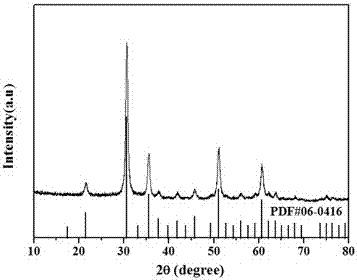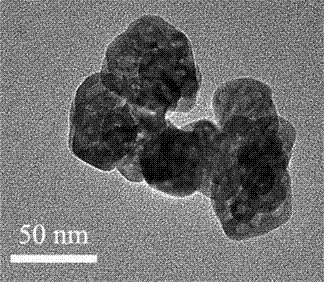A kind of preparation method of indium oxide nanoparticles with porous structure
A porous structure and nanoparticle technology, which is applied in the field of preparation of indium oxide nanoparticles, can solve the problems that the research results are difficult to obtain in a large scale, the exploration is not very in-depth, and the production cost is high.
- Summary
- Abstract
- Description
- Claims
- Application Information
AI Technical Summary
Problems solved by technology
Method used
Image
Examples
Embodiment 1
[0016] (1) Weigh a certain amount of indium chloride and dodecylamine, dissolve them in absolute ethanol, the concentration of indium chloride is 0.025mol / L, the concentration of dodecylamine is 0.025mol / L, and control the The molar ratio of indium to dodecylamine is 1:1;
[0017] (2) Move the mixed solution obtained in step (1) to a hydrothermal reaction kettle lined with polytetrafluoroethylene, conduct a hydrothermal reaction at a temperature of 170°C for 8 hours, and then use the product after the hydrothermal reaction The centrifuge is used for solid-liquid separation, and the obtained solid product is washed several times with deionized water and ethanol;
[0018] (3) Place the solid product obtained in step (2) in a drying oven, dry at 60°C for 24 hours, then put it in an alumina crucible and put it in a muffle furnace, and heat-treat it at 400°C for 3 hours to obtain indium oxide with a porous structure Powder.
Embodiment 2
[0020] (1) Weigh a certain amount of indium chloride and dodecylamine, dissolve them in absolute ethanol, the concentration of indium chloride is 0.028mol / L, the concentration of dodecylamine is 0.028mol / L, and control the The molar ratio of indium to dodecylamine is 1:1;
[0021] (2) Move the mixed solution obtained in step (1) to a hydrothermal reaction kettle lined with polytetrafluoroethylene, and conduct a hydrothermal reaction at a temperature of 180°C for 12 hours, and then use the product after the hydrothermal reaction The centrifuge is used for solid-liquid separation, and the obtained solid product is washed several times with deionized water and ethanol;
[0022] (3) Place the solid product obtained in step (2) in a drying oven, dry at 60°C for 24 hours, then put it in an alumina crucible and put it in a muffle furnace, and heat-treat it at 400°C for 3 hours to obtain indium oxide with a porous structure Powder.
Embodiment 3
[0024] (1) Weigh a certain amount of indium chloride and dodecylamine, dissolve them in absolute ethanol, in which the concentration of indium chloride is 0.028mol / L, and the concentration of dodecylamine is 0.056mol / L, and the concentration of chlorination is controlled. The molar ratio of indium to dodecylamine is 1:2;
[0025] (2) Move the mixed solution obtained in step (1) to a hydrothermal reaction kettle lined with polytetrafluoroethylene, and conduct a hydrothermal reaction at a temperature of 180°C for 12 hours, and then use the product after the hydrothermal reaction The centrifuge is used for solid-liquid separation, and the obtained solid product is washed several times with deionized water and ethanol;
[0026] (3) Place the solid product obtained in step (2) in a drying oven, dry at 60°C for 24 hours, then put it in an alumina crucible and put it in a muffle furnace, and heat-treat it at 400°C for 3 hours to obtain indium oxide with a porous structure Powder.
PUM
 Login to View More
Login to View More Abstract
Description
Claims
Application Information
 Login to View More
Login to View More - R&D
- Intellectual Property
- Life Sciences
- Materials
- Tech Scout
- Unparalleled Data Quality
- Higher Quality Content
- 60% Fewer Hallucinations
Browse by: Latest US Patents, China's latest patents, Technical Efficacy Thesaurus, Application Domain, Technology Topic, Popular Technical Reports.
© 2025 PatSnap. All rights reserved.Legal|Privacy policy|Modern Slavery Act Transparency Statement|Sitemap|About US| Contact US: help@patsnap.com



